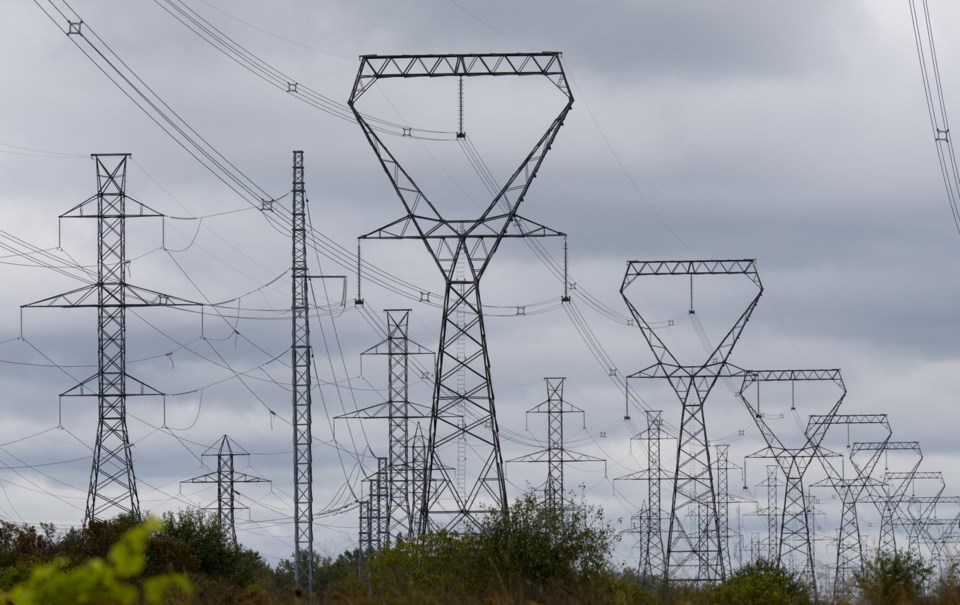TORONTO — Ontario is urging the federal government to amend proposed electricity regulations after an analysis by the province's system operator concluded the rules would mean $35 billion in additional costs by 2050 — a number environmental groups dispute.
A new analysis by the Independent Electricity System Operator looking at upcoming regulations around restrictions on emissions from electricity generation found that Ontario would have to add twice as much new generation as it is already planning, which is "not feasible" in that time frame.
But if the province were to somehow do so, building enough new electricity generation to make up for restrictions on natural gas would add $35 billion in costs by 2050, increasing residential bills by $132 to $168 per year starting in 2033, the IESO said.
Ontario Energy Minister Stephen Lecce has written to the federal ministers of the environment and energy, urging them to make changes to the rules.
"Ontario cannot support any regulatory approach that imposes thousands of dollars of new costs on consumers while compromising system reliability," Lecce wrote to Steven Guilbeault and Jonathan Wilkinson.
"While remaining on track to meet its emissions targets, Ontario continues to attract transformative investments in sectors such as automotive and the electric vehicle supply chain, life sciences and advanced manufacturing. Therefore, it is imperative that regulatory frameworks support — not hinder — our economic competitiveness."
Guilbeault and Wilkinson say they are also keeping affordability top of mind while designing the new rules, set to soon be finalized.
"When factoring in the $15 billion Ontario is estimated to receive from the federal government through Canada’s Clean Electricity Investment Tax Credit by 2050, we are making sure that there are no impacts on Ontario ratepayers, all while building a reliable, clean grid that will create countless good, sustainable, middle-class jobs for decades to come," they wrote in a joint statement.
The federal government also points to billions of dollars in investments it has made to support emissions reductions in Ontario's grid, including for nuclear projects, battery storage, and electrification of steelmaking processes.
Stephen Thomas, the clean energy manager at the David Suzuki Foundation, said in a statement that Ontario's position is "disappointing."
"It’s time for some provinces to stop looking for ways to delay or weaken climate policies and start joining the work of building solutions that provide energy cost savings, good jobs and better health outcomes for everyone," Thomas wrote.
“Affordability research and numerous modelling studies, including research by the David Suzuki Foundation, show that consumers will benefit from cheaper overall energy bills as we shift toward clean electricity, and away from high-cost fossil fuels."
Environmental Defence urged the IESO to release its full analysis, questioning how the system operator arrived at such high cost estimates when wind and solar are relatively inexpensive sources of generation.
"Ontario can meet its growing electricity needs with renewable energy when combined with storage technologies that enable the energy to be used when needed," the group wrote in a statement.
"Yet, the Ontario government seems intent on dismissing this proven path in favour of costly and polluting gas plants, which would unnecessarily drive up costs for Ontarians."
Ontario has been adding more natural gas generation to the electricity system, which the province says is necessary to ensure the grid remains reliable while nuclear plants undergo refurbishments and as demand rises faster than new nuclear and battery storage facilities can come online.
But that has also caused emissions from the electricity sector to grow. In 2021, the electricity system was 94 per cent emissions free, but that is now down to 87 per cent.
The province says that natural gas generation will ultimately help reduce emissions in the province overall by supporting broader electrification.
The IESO says in its analysis that Ontario may actually have to add more gas plants in order to meet the federal rules, as the limits on emissions are based on total gas capacity, so the more capacity, the higher the emissions allowance.
Ontario will get to a net-zero grid by 2050 without the federal regulations, the IESO says, with new nuclear and renewable resources expected to come into service in the 2040s.
This report by The Canadian Press was first published Dec. 2, 2024.
Allison Jones, The Canadian Press



